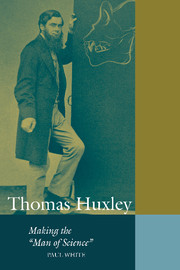Book contents
- Frontmatter
- Contents
- Illustrations
- Acknowledgments
- Introduction
- 1 Science at Home
- 2 Gentlemen of Science? Debates over Manners and Institutions
- 3 Science as Culture
- 4 The Worship of Science
- 5 “Darkest England”: Science and Labor in the 1880s and 1890s
- Conclusion: The End of the “Man of Science”
- Bibliography
- Index
Conclusion: The End of the “Man of Science”
Published online by Cambridge University Press: 25 June 2009
- Frontmatter
- Contents
- Illustrations
- Acknowledgments
- Introduction
- 1 Science at Home
- 2 Gentlemen of Science? Debates over Manners and Institutions
- 3 Science as Culture
- 4 The Worship of Science
- 5 “Darkest England”: Science and Labor in the 1880s and 1890s
- Conclusion: The End of the “Man of Science”
- Bibliography
- Index
Summary
Over the course of his career, Huxley worked to define the Victorian “man of science” through a complex set of discriminating categories embracing gender, gentlemanliness, literature, religion, and the relations of “elite” and “popular.” An absence of well-established career patterns and institutitonal structures made for an enormous diversity amongst practitioners. Scientific identity thus depended crucially on the assertion of social and cultural “others” to maintain its coherence and to secure its boundaries. In a variety of ways, Huxley's scientific self was positively constituted of these others. The “autonomous” scientific practitioner that allegedly emerged in the Victorian period as a result of professionalization was in fact a carefully wrought image that obscured a host of new social relations between men of science and heads of state, industrialists, publishers, and others. It also concealed substantial cultural borrowings from domesticity, from theology, from literature, and from empire.
Conflations of science with other social practices, such as literature and religion, facilitated friendships and working relations across professional boundaries and consolidated a more general authority of cultural elites. Science and literature were conjoined as symbolic, even fictive, creations of genius and imagination that refashioned material reality (and minds). Science and religion in turn were represented as essential components of biblical criticism and of the discovery of natural order. The joint efforts of elites in the domain of public instruction, such as the London School Board, provided spectacles of social solidarity while institutionalizing the common culture they produced.
- Type
- Chapter
- Information
- Thomas HuxleyMaking the 'Man of Science', pp. 170 - 174Publisher: Cambridge University PressPrint publication year: 2002



